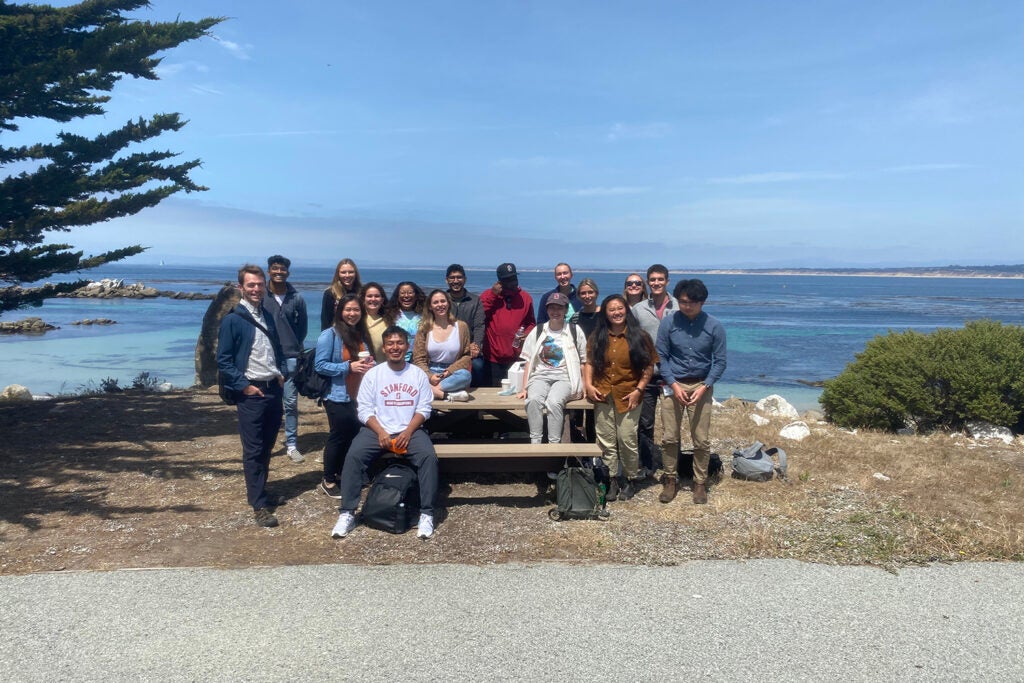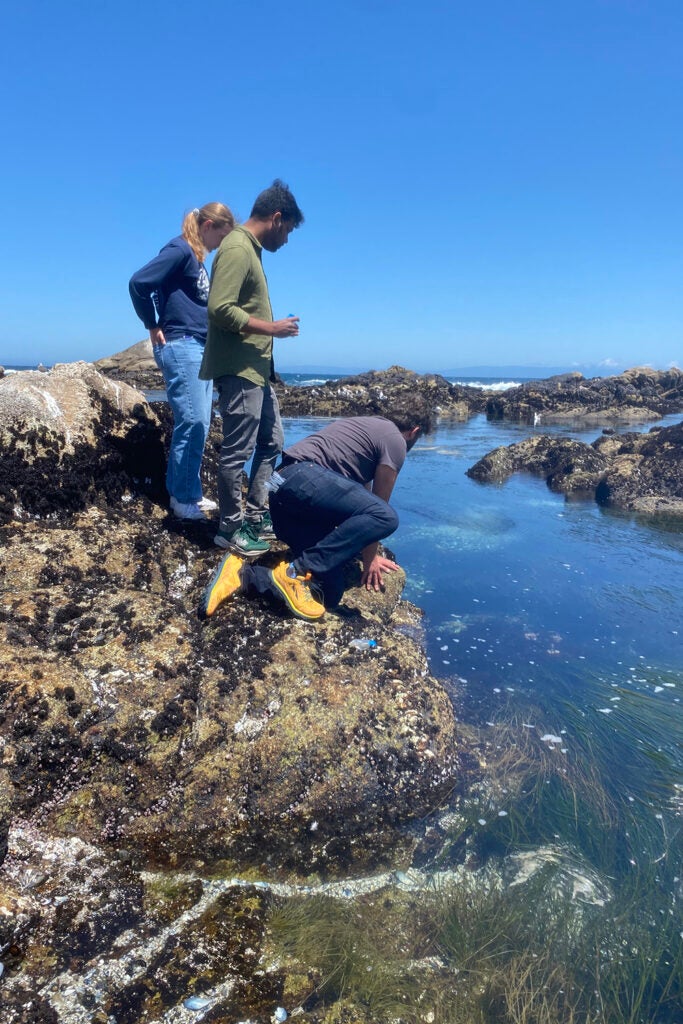Stanford Hopkins Marine Station’s new biodiversity mission
Improved facilities and equipment at the Monterey Bay station will open the door for researchers to study more of the Pacific’s diverse species, gain a deeper understanding of fundamental biology, and develop new biotechnologies.
Nabor Vázquez Martínez had never been tidepooling until he spent a month at the Stanford Hopkins Marine Station in Monterey Bay this summer. On the beach near the station, he climbed across slippery rocks and beds of mussels, touched starfish, observed sea urchins, and searched for sea worms. But just as exciting was going back to the lab to study the specimens he gathered.

Students from a developmental biology course at Hopkins, where they learned about developmental biodiversity. Lowe encourages other classes to incorporate an experiential Hopkins component to their curriculum. (Image credit: Christopher Lowe)
“I got to be submerged in the ocean for a couple hours, then took samples back to the laboratory to explore under a microscope,” he said. “It was amazing seeing life happen before my own eyes.”
Vázquez Martínez, who is working toward his PhD in biology, was a student in Developmental Biology in the Ocean: Comparative Embryology and Larval Development, which brings graduate students and faculty in biology, developmental biology, and bioengineering to Hopkins. The students spent the month of June exploring the incredible biodiversity in the nearby beaches and waters, then applying the station’s advanced tools to explore questions related to invertebrate embryology.
The class, which Hopkins has offered since 2015, is indicative of the station’s future. With funding from the School of Humanities and Sciences dean’s office and the Chan Zuckerberg Biohub, Hopkins is adding a research and teaching mission focused on mining biodiversity – delving into the genomes and molecular characteristics of the multitudes of species that live along the Pacific Coast to search for answers to important biological questions.
Christopher Lowe, an associate professor of biology at Hopkins who co-teaches the class, is leading the effort to form a center of cell and molecular biodiversity in service of this new mission. The dean’s office funding will help create a functional genomics center and a biological imaging center, while CZ Biohub is providing financial and scientific support for the mission of the center.
“If you want to understand any kind of animal diversity in any meaningful way, every animal phylum – and in fact any phylum, whether it’s plant, algae, fungi, whatever – started out their evolutionary journey in the ocean,” Lowe said. “So the ocean really is the crucible of creation.”
The people to apply biodiversity
In the past five to 10 years, improved tools have dramatically reduced the cost and increased the effectiveness of genomic and genetic research. Applying these technologies to diverse species will lead to new discoveries, Lowe said. And, in turn, asking new questions about marine life can lead to novel technologies and techniques.

David Booth, an assistant professor of biochemistry and biophysics from UCSF, shows students in Developmental Biology in the Ocean: Comparative Embryology and Larval Development how to collect Choanoflagellates, an important unicellular group for exploring the origins of multicellularity. (Image credit: Christopher Lowe)
“The opportunities are out there, and all it requires is a bold and industrious postdoc or graduate student to come up with a really interesting biological question, and then look for the right animal that matches that question,” Lowe said.
For example, Lowe’s colleague, Stanford bioengineer Manu Prakash, developed a new microscope that allows for high-resolution, real-time imaging of larvae swimming and behavior, thanks to his time at Hopkins. Before, the only way to study how the larvae of common intertidal animals like starfish or sea anemones behave in the ocean was to squish them on a microscope slide. Such research is important, said Lowe, because “marine plankton play incredibly important roles in marine ecosystems, but because of their tiny size, our understanding of their biology is rudimentary.”
The summer course students also learned how working in marine biodiversity can enrich many areas of research.
With his mind opened to other species, Vázquez Martínez – who usually studies a common model organism, the roundworm C. elegans – achieved a scientific first.
“No one has ever done an in situ hybridization chain reaction to visualize the nuclei and muscle on a juvenile mud worm – and then actually getting to do it for the first time and image our worms with colleagues in this class was an unbelievable experience,” he said.
Azalia Martínez Jaimes, a PhD student in developmental biology, studied stem cell transplantation among colonies of Botryllus schlosseri, or star tunicates, during the course. The experience will come in handy when she returns to her stem cell-focused lab on the main campus, but it also had a more profound effect – clarifying a biological truth she knew before, but never really understood until witnessing the biodiversity at Hopkins.
“One of the biggest things I learned, that continues to blow my mind, is when you’re comparing species, you’re looking back in time,” she said.
Nelson Hall, a PhD student in bioengineering, used his month at Hopkins to practice microinjection protocols – injections involving tiny needles, which Hall performed on eggs from a variety of organisms. This technique is the first step to gene editing with tools like CRISPR. Like his classmates, Hall was in awe of the number of organisms he could find and study. He urged other researchers to consider spending time at Hopkins.
“The biodiversity of the area is just through the roof,” he said. “If you’re interested in genetic engineering across a broad spectrum, you want to be able to sample a wide array of animals. If your environment happens to provide that to you on a silver platter, all the better.”
The tools to mine biodiversity
Fundamental biological challenges span every species: How do we fight off disease? How do we communicate? How do we adapt to new environments?
As Lowe and other scientists like to say, evolution has already done those experiments for us.
In the early 20th century, for example, researchers gained basic understandings of neurobiology by studying the enormous axons found in squid. As a current example, investigations of immune response beyond what’s seen in vertebrates could reveal previously undiscovered methods of protection from pathogens, explained Lowe. By exploring those differences, biologists could gain a deeper understanding of immunity in general, and apply it to other questions.
With the added benefit of more advanced equipment and application of novel genomic technologies, Lowe sees the future work at Hopkins as continuing this long tradition in biodiversity science of embracing the unknown and pursuing big questions.
“Curiosity-driven basic research can provide some incredibly valuable insights into major biological questions,” Lowe said. “A center for cellular and molecular biodiversity at Hopkins provides a portal to the incredible range of biodiversity and the opportunity to experimentally investigate the solutions to biological challenges that have evolved independently in organisms separated by hundreds of millions of years.”
Alongside offering more opportunities for the graduate students who visit each summer, the new updates at Hopkins aim to draw more researchers and students from the main campus. Lowe expects the renovations will be ready for researchers by summer 2023.
“My mission,” said Lowe, “is to persuade people at Stanford who work on these really cool technologies that have been developed – that are strongly focused on either stem cells or on mammalian development – to think about how we can apply these new tools to address really basic biological questions by diving into the diversity in the marine realm.”